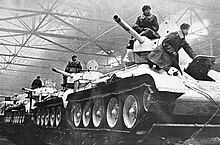Uralmash
| Uralmash | |
|---|---|
| legal form | Corporation |
| founding | July 15, 1933 in Yekaterinburg |
| Seat | Ekaterinburg |
| management | Andrei Leonidowitsch Kuznezow |
| Number of employees | 6,000 |
| sales | $ 130 million (2017) |
| Branch | mechanical engineering |
| Website | www.uralmash.ru |
| Status: 2019 | |
Uralmash (formerly Uralmaschsawod , Russian Уральский Машиностроительный Завод Uralski Maschinostroitelny Zavod , German Urals Engineering Plant ; today Уральский Завод Тяжелого Машиностроения Uralsky Zavod Tjaschelowo Maschinostrojennija , abbreviated USTM , German Ural Heavy Machinery Factory , also Uralmaschplant ) is a Russian company of heavy machinery in Yekaterinburg with additional production capacity in Orsk .
History and products
Uralmash was built as part of the 1st Soviet five-year plan 1928–1933 as an important component of Stalin's industrialization policy at a site of the metal industry in Sverdlovsk (now Yekaterinburg) that had existed for 200 years. The plant went into operation in 1933 and has been manufacturing equipment for the iron and steel industry (especially for foundries and rolling mills) as well as for mines ever since. In addition, crushers and excavators were produced for use in quarries. During the Second World War , the manufacturing concentrated exclusively on armaments. 30,000 artillery pieces and 5,500 tanks and self-propelled guns were built here . a. the T-34 , the SU-100 and the SU-122 as well as the M-30 howitzer .
After the war, Uralmash specialized in the manufacture of large mining machines, including a. on large excavators for opencast mining (such as the EKG series ), rock crushers and mills, later also on continuous casting plants and oil and gas drilling equipment including offshore technology for oil production in the Caspian Sea . Uralmash also supplied the system for the record deep drilling of 12.3 kilometers on the Kola Peninsula from 1970 to 1989, from which 45,000 rock samples were taken.
After the Soviet era, when the company temporarily employed up to 16,500 people, Uralmash was converted into a joint stock company and the workforce was greatly reduced. In 1996 Uralmasch was merged with the Petersburg company for power plant and nuclear energy technology Izhora ( Uralmasch-Izhora ) and thus incorporated into the largest Russian mechanical engineering group OMS (OMZ). In 2005 the drilling rig business and the development team went to the Integra Group. Around 2010 the drilling rig business was resumed as part of the restructuring by the Gazprom Group. The Uralmash shares were taken over by a closed-end investment fund of Gazprombank in 2015 , which separated the mining, oil and gas production technology from the power plant construction. Today the company employs around 6,000 people. Subsidiaries are also active in the service sector.
Others
The residential area around the extensive company is also called Uralmash. The residential town, partly in the constructivist style, which replaced hundreds of barracks accommodation, as well as the factory management building and the trading house were built between 1929 and 1935, since 1932 partly with the significant participation of Bauhaus student Béla Scheffler , who worked with the Bauhaus brigade from Hannes Meyer had gone to the Soviet Union. The Uralmash metro station is also nearby . The company football club Uralmashstroj (or later Uralmashsavod and Uralmash Sverdlovsk ), which was founded in 1930 when the company was being built, is now called FK Ural Yekaterinburg .
See also
Web links
- The company's website (English)
Individual evidence
- ↑ a b Max Scholz: Yearbook Construction Machines 2019. Podszun-Verlag, 2018, ISBN 978-3-86133-894-9 , page 71.
- ↑ Soviet Union digs deepest hole on earth , in: www.planet-schule.de, May 15, 1992.
- ^ Bauhaus University Weimar : The Bauhaus in the Urals .

